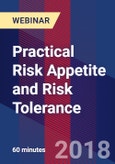Why Should You Attend:
A Risk Policy Statement should describe the overall approach, including policies, processes, controls, and systems, through which risk preferences, tolerance and appetite are established, communicated, and monitored.It also includes a risk appetite statement, risk parameters or limits, and an outline of the roles and responsibilities of those overseeing the implementation and monitoring of the Risk Policy.
While significant progress has been made since the financial crisis to develop risk appetite limits and to calculate actual exposure to financial risks (e.g. credit, market), operational risk is still expressed by and large in a qualitative and aspirational manner, with little or no quantification.
This webinar will explain how to develop and implement a risk policy statement.
Areas Covered in the Webinar:
- The basic concepts and links between risk appetite, governance and corporate performance
- The impact of organizational strategy on risk appetite
- How to define risk appetite, tolerance and thresholds
- Applying risk appetite techniques to overcome challenges and establish monitoring tools
- Developing key risk indicators and key control indicators based on the risk appetite metrics
- Managing and developing a risk appetite framework and program to add value to strategic decision making
- Establishing roles and ownership for risk appetite
Who Will Benefit:
- Risk Officers
- Compliance Officers
- Internal and External Auditors
- Financial Controllers/Officers
- Operations Managers
- Treasurers
- Board Members
- Business Managers
- Investment Managers
- Banks
- Asset Managers
- Broker/Dealers
- Insurance Companies and all other financial institutions.
- Operational Risk Managers
- General (legal) counsel
- CFOs (Chief Financial Officers)
- COO (Chief Operating Officers)
- CRO (Chief Risk Officers)
Speaker
Mario MosseCourse Provider

Mario Mosse,









